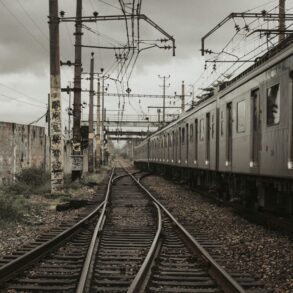Aleksandr Lukashenko, currently celebrating his 27th year as president, has held a near-constant media presence. From his repressive crackdown on the pro-democracy protests last year, to his decision to force a commercial plane to land in Belarus and to the recent border issue with Poland, Lukashenko has made himself somewhat of a thorn in the side of the West.
Having held the position since 1994, Lukashenko had a unique chance to build a new national identity. His control over the Belarusian state has meant that he has had a free reign to construct a Belarus in his image. He used this time to heavily reconnect Belarus with its Soviet past. He reinstated the Soviet Belarussian flag and coat of arms, but cleared them of communist symbols. Lukashenko also made Russian a state language and promoted solidarity with Russia, while emphasising Belarus’ and Russia’s shared historic legacy in regard to the Kievan Rus, a medieval kingdom and the predecessor to modern day Russia, Belarus and Ukraine.
Lukashenko focused on creating a national discourse and identity that drew heavily on the Soviet past, which was seen as a period of great industrialisation and growth in living standards, a sort of golden age. But there has also been an attempt to make a clear connection to modern Russia, in contrast to other post-Soviet countries that have attempted to move Westwards.

The Great Patriotic War became the most powerful tool when sculpting the Belarusian identity. Here, the Soviet myth of the partisan republic was revived by Lukashenko where he emphasised the heroic and self-sacrificing Belarusians who rid the world of Nazism. In order to establish his own political powerbase, president Lukashenko drew comparisons between opposition parties and the Nazis by stating that those who oppose him are the heirs of Nazi collaborators. The opposition was not only framed as an enemy to the regime, but also as an enemy to the nation. At the same time, he managed to fashion himself as the true successor to the victors of the Second World War. This became so systematic that that the word “opposition” became inseparable from the Nazi connotation that Lukashenko tried to instill.
Thus we can see how Lukashenko managed to sculpt an image of himself as Belarus’ only true protector. This is a major reason behind the systematic election rigging that aimed to safeguard the image of a unified Belarus. In this reality, Lukashenko could present himself as the only viable leader, who could speak for all Belarusians.
A new Belarus takes shape?
In recent years, the Russian aspect of Lukashenko’s construction of a new nation has been toned down while making the Belarusian nation more distinct. The increased use of the Belarusian language in schools, along with a wider acceptance of pre-soviet symbolism have become more normal. In 2014, Lukashenko held a speech in Belarusian for the first time since the 1990s. The authorities have also become progressively less hostile towards people using differing national symbols. Yet,we should not underestimate the importance of Soviet-era symbolism and the Great Patriotic War in the national discourse. This became apparent during last year’s widespread protests, which began with demands for free and fair elections, but evolved into a promotion of an alternate national identity still grounded in the Soviet myth of the partisan republic.
The protesters did two things: First, they brought back pre-Soviet and pre-Russian empire symbols. The most prevalent being the white-red-white flag and the Pahonia coat of arms dating back to the grand duchy of Lithuania and the Poland-Lithuanian Commonwealth. Second, the protesters reappropriated existing Soviet symbols already established by Lukashenko. The theme of the Nazi collaborators that had been projected onto the opposition had now been reversed onto the regime’s forces who had been heavily supressing the demonstrators. A popular term that they applied to the forces was “punisher”. This term has a strong negative connotation in Belarusian society: it was first applied to Nazi soldiers that were burning down villages in an attempt to quell guerilla warfare during WWII. The protesters also reused an iconic Second World War poster where they replaced the original figure with a jailed opposition figure. The biggest rallies usually occurred at an important World War II memorial site called Victory Stela.

(Credit: Castleski / Shutterstock.com)
The legacy of Lukashenko’s Belarus which took a more distinctive turn in 2014 and the legacy of the protesters’ alternate narratives have sparked fears among several Russian commentators. They have routinely discussed how there is little difference between Russia and Belarus, how the republic is an artificial creation and that the country’s wish to create a distinctive identity is based on Russophobia. This can be viewed as fear of losing influence over Belarus. However, given that Belarus is economically and militarily dependent on Russia gives us reason to doubt the possibility of change of foreign policy and geo-political alliance in the foreseeable future.
The question of the Belarusian identity—Lukashenko relied on this for a long time as a source for his power—may be on its way out. According to Gustav Gressel, a senior policy fellow at the European Council on Foreign Relations, the cult of personality aspect of Lukashenko’s narrative may be losing its legitimacy. Different reasons can be presented for this: the protests and the current international political climate being two of them.
Even though the pro-democracy protests have died down, they managed to propose a different vision of what it means to be Belarusian. This has rocked the boat of Belarusian politics and seriously harmed Lukashenko’s monopoly of the Belarusian identity. With respect to the political climate, Gustav Gressel says that while other authoritarian regimes have constructed new narratives, Lukashenko no longer has one. These new narratives feature Orban as the protector of Christianity, Erdogan revitalising the glory of the Ottoman empire and Putin restoring the prestige of the Soviet Union. This leads us to wonder: is the legitimacy of Lukashenko’s presidency petering away?
Christopher Fletcher-Sandersjöö




